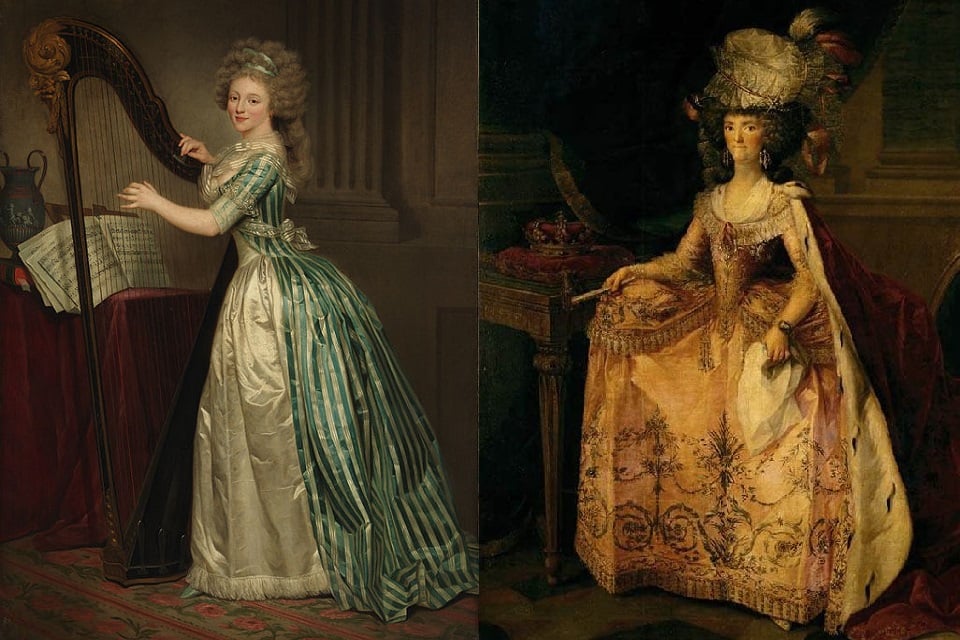Fashion between 1785–1795, Inclusion in the Louis XVI style fashion and the Neoclassical fashion. Affected by Marie Antoinette, costumes in court become more luxurious. Simultaneously, the Neoclassical fashion developed,as an idealized and orderly and inherently worthy model for the arts to follow.
Fashion between 1785–1795 in Western culture became simpler and less elaborate. These changes were a result of emerging modern ideals of selfhood, the declining fashionability of highly elaborate Rococo styles, and the widespread embrace of the rationalistic or “classical” ideals of Enlightenment philosophes.
After 1780 the silhouette changes completely; there is an English, rural and natural style à l’anglaise. The woman wears a gown over a cul de Paris or queue (cushion at the back of the back), with tight sleeves and a deep neckline filled with a white scarf that is sometimes folded and buttoned on the back. This S-line is reinforced by the large wide frilly hairstyles and the very large hats with ribbons, feathers and flowers. The shoes are fine, have a point and a heel, and are decorated with buckles, embroidery, bow or precious stones.
French Revolution
As the radicals and Jacobins became more powerful, there was a revulsion against high-fashion because of its extravagance and its association with royalty and aristocracy. It was replaced with a sort of “anti-fashion” for men and women that emphasized simplicity and modesty.
High fashion and extravagance returned to France and its satellite states under the Directory, 1795–99, with its “directoire” styles; the men did not return to extravagant customs. These trends would reach their height in the classically-styled fashions of the late 1790s and early 19th century.
Women’s fashion
Overview
When Marie Antoinette turned thirty, she decided it was no longer decent for her to dress in this way and returned to more acceptable courtly styles, though she still dressed her children in the style of the gaulle, which may have continued to reflect badly on the opinion of their mother even though she was making visible efforts to rein in her own previous fashion excess. However, despite the distaste with the queen’s inappropriate fashions, and her own switch back to traditional dress later in life, the gaulle became a popular garment in both France and abroad. Despite its controversial beginnings, the simplicity of the style and material became the custom and had a great influence on the transition into the neoclassical styles of the late 1790s.
During the years of the French Revolution, women’s dress expanded into different types of national costume. Women wore variations of white skirts, topped with revolutionary colored striped jackets, as well as white Greek chemise gowns, accessorized with shawls, scarves, and ribbons.
By 1790, skirts were still somewhat full, but they were no longer obviously pushed out in any particular direction (though a slight bustle pad might still be worn). The “pouter-pigeon” front came into style (many layers of cloth pinned over the bodice), but in other respects women’s fashions were starting to be simplified by influences from Englishwomen’s country outdoors wear (thus the “redingote” was the French pronunciation of an English “riding coat”), and from neo-classicism. By 1795, waistlines were somewhat raised, preparing the way for the development of the empire silhouette and unabashed neo-classicism of late 1790s fashions.
Gowns
The usual fashion at the beginning of the period was a low-necked gown (usually called in French a robe), worn over a petticoat. Most gowns had skirts that opened in front to show the petticoat worn beneath. As part of the general simplification of dress, the open bodice with a separate stomacher was replaced by a bodice with edges that met center front.
The robe à la française or sack-back gown, with back pleats hanging loosely from the neckline, long worn as court fashion, made its last appearance early in this period. A fitted bodice held the front of the gown closely to the figure.
The robe à l’anglaise or close-bodied gown featured back pleats sewn in place to fit closely to the body, and then released into the skirt which would be draped in various ways. Elaborate draping “à la polonaise” became fashionable by the mid-1770s, featuring backs of the gowns’ skirts pulled up into swags either through loops or through the pocket slits of the gown.
Front-wrapping thigh-length shortgowns or bedgowns of lightweight printed cotton fabric remained fashionable at-home morning wear, worn with petticoats. Over time, bedgowns became the staple upper garment of British and American female working-class street. Women would also often wear a neck handkerchief, sometimes for modesty reasons. In surviving artwork, there are few women depicted wearing bedgowns without a handkerchief. These large handkerchiefs could be of linen, plain, colored or of printed cotton for working wear. Wealthy women wore handkerchiefs of fine, sheer fabrics, often trimmed with lace or embroidery with their expensive gowns.
Jackets and redingotes
An informal alternative to the dress was a costume of a jacket and petticoat, based on working class fashion but executed in finer fabrics with a tighter fit.
The caraco was a jacket-like bodice worn with a petticoat, with elbow-length sleeves. By the 1790s, caracos had full-length, tight sleeves.
As in previous periods, the traditional riding habit consisted of a tailored jacket like a man’s coat, worn with a high-necked shirt, a waistcoat, a petticoat, and a hat. Alternatively, the jacket and a false waistcoat-front might be a made as a single garment, and later in the period a simpler riding jacket and petticoat (without waistcoat) could be worn.
Another alternative to the traditional habit was a coat-dress called a joseph or riding coat (borrowed in French as redingote), usually of unadorned or simply trimmed woolen fabric, with full-length, tight sleeves and a broad collar with lapels or revers. The redingote was later worn as an overcoat with the light-weight chemise dress.
Underwear
The shift, chemise (in France), or smock, had a low neckline and elbow-length sleeves which were full early in the period and became increasingly narrow as the century progressed. Drawers were not worn in this period.
Strapless stays were cut high at the armpit, to encourage a woman to stand with her shoulders slightly back, a fashionable posture. The fashionable shape was a rather conical torso, with large hips. The waist was not particularly small. Stays were usually laced snugly, but comfortably; only those interested in extreme fashions laced tightly. They offered back support for heavy lifting, and poor and middle class women were able to work comfortably in them. As the relaxed, country fashion took hold in France, stays were sometimes replaced by a lightly boned garment called “un corset,” though this style did not achieve popularity in England, where stays remained standard through the end of the period.
Panniers or side-hoops remained an essential of court fashion but disappeared everywhere else in favor of a few petticoats. Free-hanging pockets were tied around the waist and were accessed through pocket slits in the side-seams of the gown or petticoat. Woolen or quilted waistcoats were worn over the stays or corset and under the gown for warmth, as were petticoats quilted with wool batting, especially in the cold climates of Northern Europe and America.
Footwear and accessories
Shoes had high, curved heels (the origin of modern “louis heels”) and were made of fabric or leather. Shoe buckles remained fashionable until they were abandoned along with high-heeled footwear and other aristocratic fashions in the years after the French Revolution, The long upper also was eliminated, essentially leaving only the toes of the foot covered. The slippers that were ordinarily worn with shoes were abandoned because the shoes had become comfortable enough to be worn without them. Fans continued to be popular in this time period, however, they were increasingly replaced, outdoors at least, by the parasol. Indoors the fan was still carried exclusively. Additionally, women began using walking sticks.
Hairstyles and headgear
The 1770s were notable for extreme hairstyles and wigs which were built up very high, and often incorporated decorative objects (sometimes symbolic, as in the case of the famous engraving depicting a lady wearing a large ship in her hair with masts and sails—called the “Coiffure à l’Indépendance ou le Triomphe de la liberté”—to celebrate naval victory in the American war of independence). These coiffures were parodied in several famous satirical caricatures of the period.
By the 1780s, elaborate hats replaced the former elaborate hairstyles. Mob caps and other “country” styles were worn indoors. Flat, broad-brimmed and low-crowned straw “shepherdess” hats tied on with ribbons were worn with the new rustic styles.
Hair was powdered into the early 1780s, but the new fashion required natural colored hair, often dressed simply in a mass of curls.
Style gallery 1785–1790
 1 – 1786 |
 2 – 1787 |
 3 – 1787 |
 4 – 1789 |
|---|
1.Fashion plate of 1786 shows a caraco and petticoat, worn with a wide-brimmed summer hat of straw with elaborate trimmings.
2.Miss Constable, 1787, wears a chemise dress with plain sleeves and a narrow sash. She wears her hair down in a mass of curls under her straw hat.
3.The Marquise de Pezay and the Marquise de Rouge wear colorful dresses in the new style, one blue and one striped, with sashes and high-necked chemises beneath. The Marquise de Rougé wears a scarf or kerchief wrapped into a turban.
4.Elizabeth Sewall Salisbury wears an oversized mob cap trimmed with a wide satin ribbon and a kerchief pinned high at the neckline. America, 1789.
Style gallery 1790–1795
 1 – 1790 |
 2 – c. 1791 |
 3 – 1791 |
 4 – 1792 |
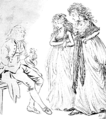 5 – 1790s |
|---|---|---|---|---|
 6 – 1793 |
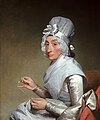 7 – 1793 |
 8 – 1794 |
 9 – 1795 |
1.Redingote or riding coat of c. 1790, with “pouter-pigeon” front. This lady wears a mannish top hat for riding and carries her riding crop.
2.Self-portrait of Rose Adélaïde Ducreux with harp.
3.1791 illustration of woman playing with an early form of yo-yo (or “bandalore”) shows slight bust draping, which in more extreme form became the “pouter pigeon” look.
4.Illustration of women’s fashion from 1792
5.Sketch by Isaac Cruikshank (father of George), showing both male and female middle-class English styles of the early 1790s.
6.La Comtesse Bucquoi wears a sashed gown with a high-necked, frilled chemise beneath, a turban on her head, and a newly fashionable scarlet shawl. 1793.
7.Mrs. Richard Yates, 1793, wears a very conservative gown with a kerchief and a gathered mob cap with a large ribbon bow.
8.María Rita de Barrenechea y Morante, Marchioness of la Solana
9.The Duchess of Alba wears a simple white gown, with a red sash and bow on her low collar. She wears her hair loose and free. This portrait shows the influence of French fashion in Spain at the end of the 18th century, 1795.
French fashion 1785-1795
 France, 1788 |
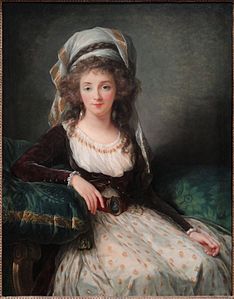 France, 1789 |
 France, 1789 |
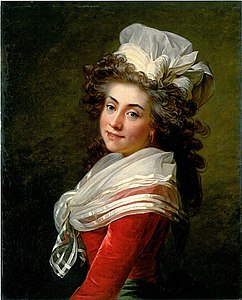 France, 1790 |
 France, 1792 |
|---|
Spanish fashion 1785-1795
 Spain, 1785 |
 Spain, 1785 |
 Spain, 1787 |
 Spain, 1789 |
 Spain, 1789 |
|---|---|---|---|---|
 Spain, 1790 |
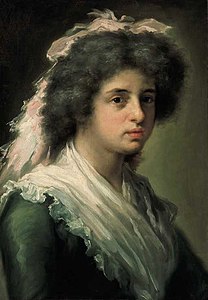 Spain, 1792 |
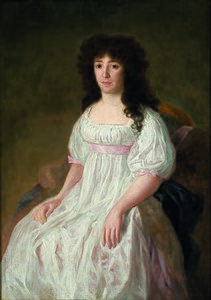 Spain, 1794 |
 Spain, 1795 |
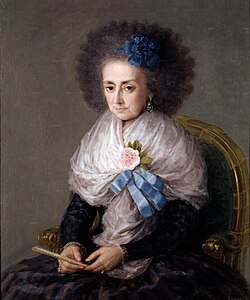 Spain, 1795 |
Source from Wikipedia
